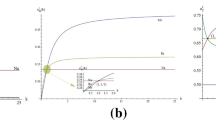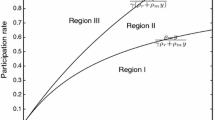Abstract
Cooperative advertising plays a strategically important role in marketing programs. In this paper, we use a game theoretical model to study not only cooperative advertising but also pricing strategy in a manufacturer—e-retailer supply chain with the consideration of product categories. First, two cooperative advertising models (the leader-follower Stackelberg and the strategic alliance) are established and analyzed. We then compare the two models to develop some important theories and managerial insights. Furthermore, we utilize a bargaining model to implement profit sharing and determine the manufacturer’s participation rate for cooperative advertising in the channel coordination of strategic alliance. Based on our results, we derive optimal market strategies and identify probable paths of future research.


Similar content being viewed by others
References
Balasubramanian, S. (1998). Mail versus mall: a strategic analysis of competition between direct markets and conventional retailers. Marketing Science, 17, 181–195.
Bergen, M., & John, G. (1997). Understanding cooperative advertising participation rates in conventional channels. Journal of Marketing Research, 35, 357–369.
Berger, P. D. (1972). Vertical cooperative advertising ventures. Journal of Marketing Research, 9, 309–312.
Chiang, W. Y., Chhajed, D., & Hess, J. D. (2003). Direct marketing, indirect profits: a strategic analysis of dual-channel supply chain design. Management Science, 49(1), 1–20.
Dant, R. P., & Berger, P. D. (1996). Modeling cooperative advertising decisions in franchising. The Journal of the Operation Research Society, 47(9), 1120–1136.
Gerstner, E., & Hess, J. (1995). Pull promotions and channel coordination. Marketing Science, 14(1), 43–60.
Houk, B. (1995). Co-op advertising. Lincolnwood: NTC.
Huang, Z., & Li, S. X. (2001). Co-op advertising models in a manufacturer-retailer supply chain: A game theory approach. European Journal of Operational Research, 135(3), 527–544.
Huang, Z. M., Li, S. X., & Mahajan, V. (2002). An analysis of manufacturer-retailer supply chain coordination in cooperative advertising. Decision Sciences, 33, 1–20.
Ingene, C. A., & Parry, M. (1995). Channel coordination when retailers compete. Marketing Science, 14(4), 360–377.
Iyer, G. (1998). Coordinating channels under price and nonprice competition. Marketing Science, 17, 338–355.
Jeuland, A. P., & Shugan, S. M. (1983). Managing channel profits. Marketing Science, 2(3), 239–272.
Kacen, J., Hess, J., & Chiang, W. K. (2002). Bricks or clicks? Consumer attitudes toward traditional stores and online stores. Champaign: Working paper, University of Illinois.
Karry, S., & Zaccour, G. (2006). Could co-op advertising be a manufacturer’s counterstrategy to store brands? Journal of Business Research, 59, 1008–1015.
Kim, S. Y., & Staelin, R. (1999). Manufacturer allowances and retailer pass-through rates in a competitive environment. Management Science, 18(1), 59–76.
Korgaonkar, P., Silverblatt, R., & Girard, T. (2006). Online retailing, product classifications, and consumer preferences. Internet Research, 16(3), 267–287.
Koulamas, C. (2006). A newsvendor problem with revenue sharing and channel coordination. Decision Sciences, 37(1), 91–100.
Kumar, N., & Ruan, R. (2006). On manufacturers complementing the traditional retail channel with a direct online channel. Quantitative Marketing and Economics, 4(3), 289–323.
Kwak, H., Fox, R. J., & Zinkhan, G. M. (2002). What products can be successfully promoted and sold via the Internet? Journal of Advertising Research, 2, 23–38.
Lal, R., & Sarvay, M. (1999). When and how is the Internet likely to decrease price competition? Marketing Science, 18(4), 485–503.
Li, S. X., Huang, Z. M., Zhu, J., & Chau, P. Y. K. (2002). Cooperative advertising, game theory and manufacturer-retailer supply chains. Omega, 30(5), 347–360.
Little, J. D. C. (1979). Aggregate advertising models: The state of the art. Operations Research, 27, 619–627.
McGuire, T. W., & Staelin, R. (1983). An industry equilibrium analysis of downstream vertical integration. Marketing Science, 2(2), 161–191.
Nash, J. F. (1950). The bargaining problem. Econometrica, 18, 155–162.
Raju, J. S., & Zhang, J. Z. (2005). Channel coordination in the presence of a dominant retailer. Marketing Science, 24(2), 254–262.
Rosenbloom, B. (2003). Marketing channels: A management view. Thomson South-Western.
Somers, T. M., Gupta, Y. P., & Herriott, S. R. (1990). Analysis of cooperative advertising expenditures: a transfer-function modeling approach. Journal of Advertising Research, 10(11), 35–45.
Von Stackelberg, H. F. (1934). Market form und Gleichgewicht (Market Structure and Equilibrium). Berlin: Springer.
Stewart, D. W., & Pavlou, P. A. (2002). From consumer response to active consumer: Measuring the effectiveness of interactive media. Journal of the Academy of Marketing Science, 30(4), 376–396.
Weng, Z. K. (1995). Channel coordination and quantity discounts. Management Science, 41(9), 1509–1521.
Yan, R., & Pei, Z. (2009). Retail services and firm profit in a dual-channel market. Journal of Retailing and Consumer Services, 16(4), 306–314.
Acknowledgement
The author gratefully acknowledges the Editor, Dr. G. Tomas M. Hult, and former Editor, Dr. David W. Stewart, and four anonymous reviewers for their constructive comments and suggestions that were instrumental in improving this paper.
Author information
Authors and Affiliations
Corresponding author
Appendices
Appendix 1
The profit for the manufacturer is as follows:
Similarly, for the e-retailer, the profit is as follows:
The total profit for the whole supply chain is as follows:
Taking the derivative of (A3) with respect to p and A, respectively, and letting \( \left( {{{\partial {\pi_r}} \mathord{\left/{\vphantom {{\partial {\pi_r}} {\partial p}}} \right.} {\partial p}}} \right) = 0 \) and \( \left( {{{\partial {\pi_r}} \mathord{\left/{\vphantom {{\partial {\pi_r}} {\partial A}}} \right.} {\partial A}}} \right) = 0 \) yields:
Substituting (A5) and (A6) into (A2), then by the differential of π m on w, Q and t, respectively, and letting \( \left( {{{\partial {\pi_m}} \mathord{\left/{\vphantom {{\partial {\pi_m}} {\partial w}}} \right.} {\partial w}}} \right) = 0 \), \( \left( {{{\partial {\pi_m}} \mathord{\left/{\vphantom {{\partial {\pi_m}} {\partial Q}}} \right.} {\partial Q}}} \right) = 0 \) and \( \left( {{{\partial {\pi_m}} \mathord{\left/{\vphantom {{\partial {\pi_m}} {\partial t}}} \right.} {\partial t}}} \right) = 0 \), we obtain:
Substituting (A7), (A8) and (A9) into all of the functions, we then obtain all of results listed in Table 2.
Appendix 2
Because \( {w_S} = \frac{{4{k^2}\theta + {\lambda^2}{r^2}\theta \sqrt {9 + \frac{{16{k^2}\left( {{k^2} + {\lambda^2}{r^2}} \right)}}{{{\lambda^4}{r^4}}}} }}{{9{\lambda^2}{r^2} + 16{k^2}}} \) and \( {Q^S} = \frac{{{k^2}w_S^2{{\left( {\theta - {w_S}} \right)}^2}}}{{16}} \), thus it is easy to prove that \( {{\partial {Q^S}} \mathord{\left/{\vphantom {{\partial {Q^S}} {\partial k > 0}}} \right.} {\partial k > 0}} \), \( {{\partial {Q^S}} \mathord{\left/{\vphantom {{\partial {Q^S}} {\partial \theta > 0}}} \right.} {\partial \theta > 0}} \) and \( {{\partial {Q^S}} \mathord{\left/{\vphantom {{\partial {Q^S}} {\partial \lambda\kern1.5pt<\kern1.5pt0}}} \right.} {\partial \lambda\kern1.5pt<\kern1.5pt0}} \). Similarly, we can easily prove that \( {{\partial {A^S}} \mathord{\left/{\vphantom {{\partial {A^S}} {\partial k\kern1.5pt<\kern1.5pt0}}} \right.} {\partial k\kern1.5pt<\kern1.5pt0}} \), \( {{\partial {A^S}} \mathord{\left/{\vphantom {{\partial {A^S}} {\partial \lambda > 0}}} \right.} {\partial \lambda > 0}} \), \( {{\partial {A^S}} \mathord{\left/{\vphantom {{\partial {A^S}} {\partial r > 0}}} \right.} {\partial r > 0}} \), \( {{\partial {A^S}} \mathord{\left/{\vphantom {{\partial {A^S}} {\partial {t^S} > 0}}} \right.} {\partial {t^S} > 0}} \), \( {{\partial {A^S}} \mathord{\left/{\vphantom {{\partial {A^S}} {\partial \theta > 0}}} \right.} {\partial \theta > 0}} \); \( {{\partial {p^S}} \mathord{\left/{\vphantom {{\partial {p^S}} {\partial \theta > 0}}} \right.} {\partial \theta > 0}} \),\( {{\partial {w_S}} \mathord{\left/{\vphantom {{\partial {w_S}} {\partial \theta > 0}}} \right.} {\partial \theta > 0}} \), \( {{\partial {p^S}} \mathord{\left/{\vphantom {{\partial {p^S}} {\partial k > 0}}} \right.} {\partial k > 0}} \), \( {{\partial {p^S}} \mathord{\left/{\vphantom {{\partial {p^S}} {\partial \lambda\kern1.5pt<\kern1.5pt0}}} \right.} {\partial \lambda\kern1.5pt<\kern1.5pt0}} \), \( {{\partial {w_S}} \mathord{\left/{\vphantom {{\partial {w_S}} {\partial k > 0}}} \right.} {\partial k > 0}} \), \( {{\partial {w^S}} \mathord{\left/{\vphantom {{\partial {w^S}} {\partial \lambda\kern1.5pt<\kern1.5pt0}}} \right.} {\partial \lambda\kern1.5pt<\kern1.5pt0}} \), \( {{\partial {w_S}} \mathord{\left/{\vphantom {{\partial {w_S}} {\partial \theta > 0}}} \right.} {\partial \theta > 0}} \), \( {{\partial {t^S}} \mathord{\left/{\vphantom {{\partial {t^S}} {\partial k > 0}}} \right.} {\partial k > 0}} \), \( {{\partial {t^S}} \mathord{\left/{\vphantom {{\partial {t^S}} {\partial \lambda > 0}}} \right.} {\partial \lambda > 0}} \) and \( {{\partial {t^S}} \mathord{\left/{\vphantom {{\partial {t^S}} {\partial \theta = 0}}} \right.} {\partial \theta = 0}} \).
Appendix 3
Thus taking the derivative of π A on p, Q and A, respectively, and letting \( ({{\partial {\pi_A}} \mathord{\left/{\vphantom {{\partial {\pi_A}} {\partial p}}} \right.} {\partial p}}) = 0 \), \( \left( {{{\partial {\pi_A}} \mathord{\left/{\vphantom {{\partial {\pi_A}} {\partial Q}}} \right.} {\partial Q}}} \right) = 0 \) and \( \left( {{{\partial {\pi_A}} \mathord{\left/{\vphantom {{\partial {\pi_A}} {\partial A}}} \right.} {\partial A}}} \right) = 0 \), we then obtain:
Substituting (A11) into all of the functions, then we obtain all of results listed in Table 3.
Appendix 4
Because \( {w_S} = \frac{{4{k^2}\theta + {\lambda^2}{r^2}\theta \sqrt {9 + \frac{{16{k^2}\left( {{k^2} + {\lambda^2}{r^2}} \right)}}{{{\lambda^4}{r^4}}}} }}{{9{\lambda^2}{r^2} + 16{k^2}}} \), we let \( g = \frac{k}{{\lambda r}} \), then we have \( {w_S} = \frac{{4{g^2}\theta + \theta \sqrt {9 + 16{g^2}\left( {1 + {g^2}} \right)} }}{{9 + 16{g^2}}} \), \( {{\partial {w_S}} \mathord{\left/{\vphantom {{\partial {w_S}} {\partial g > 0}}} \right.} {\partial g > 0}} \) and g > 0, thus we obtain \( \frac{\theta }{3}{|_{g = 0}} \leqslant {w_S} \leqslant \frac{\theta }{2}{|_{g \to \infty }} \). Also, \( {\pi_T} = \frac{{{{\left( {\theta - {w_S}} \right)}^2}\left( {2\left( {5 + 8{g^2}} \right){w_S}\theta + 3w_S^2 + 3{\theta^2}} \right)}}{{256}} \), thus we obtain \( {{\partial {\pi_T}} \mathord{\left/{\vphantom {{\partial {\pi_T}} {\partial {w_S}\kern1.5pt<\kern1.5pt0}}} \right.} {\partial {w_S}\kern1.5pt<\kern1.5pt0}} \). \( {\pi_T}\kern1.5pt<\kern1.5pt{\pi_T}{|_{{w_S} = \theta /3}} = \frac{{{\theta^4}\left( {5 + 4{g^2}} \right)}}{{1296}} \). Furthermore, \( {\pi_A} = \frac{{{\theta^4}\left( {1 + {g^2}} \right)}}{{64}} \).
Thus, it is easy to prove that \( {\pi_A} > {\pi_T}{|_{{w_S} = \theta /3}} \). Thus, we have \( {\pi_A} > {\pi_T} \).
By the same way, we can prove that A A > A S, p A < p S and D A > D S.
Thus, Proposition 2 is proved.
Appendix 5
Let \( f = \frac{{4{g^2} + \sqrt {9 + 16{g^2}\left( {1 + {g^2}} \right)} }}{{9 + 16{g^2}}} \), thus \( {w_S} = f\theta \).
Thus, \( {\pi_T} = \frac{{{\theta^4}{{\left( {1 - f} \right)}^2}\left( {2f\left( {5 + 8{g^2}} \right) + 3{f^2} + 3} \right)}}{{256}} \) and \( {\pi_A} = \frac{{{\theta^4}\left( {1 + {g^2}} \right)}}{{64}} \),
So \( \partial ({\pi_A} - {\pi_T})/\partial \theta = \frac{{{\theta^3}\left( {4\left( {1 + {g^2}} \right) - {{\left( {1 - f} \right)}^2}\left( {2f\left( {5 + 8{g^2}} \right) + 3{f^2} + 3} \right)} \right)}}{{64}} > 0. \)
Thus, Proposition 3 is proved.
Appendix 6
If the profit sharing is successful, the acceptable schemes to the manufacturer and the e-retailer respectively are:
From Appendix 4, we know \( {\pi_A} > {\pi_T} = \pi_m^S + \pi_r^S. \)
Thus, we have \( \pi_m^P + \pi_r^P = {\pi_A} > \pi_m^S + \pi_r^S. \)
Therefore, Proposition 4 is proved.
Rights and permissions
About this article
Cite this article
Yan, R. Cooperative advertising, pricing strategy and firm performance in the e-marketing age. J. of the Acad. Mark. Sci. 38, 510–519 (2010). https://doi.org/10.1007/s11747-009-0171-z
Received:
Accepted:
Published:
Issue Date:
DOI: https://doi.org/10.1007/s11747-009-0171-z




